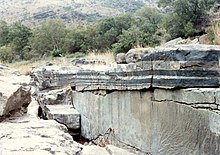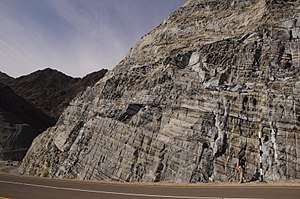Cumulate rock
These accumulations typically occur on the floor of the magma chamber, although they are possible on the roofs if anorthite plagioclase is able to float free of a denser mafic melt.In intrusions which have a uniform composition and minimal textural and mineralogical layering or visible crystal accumulations it is inappropriate to describe them according to this convention.The foremost problem is that in large ultramafic intrusions, assimilation of wall rocks tends to alter the chemistry of the melt as time progresses, so measuring groundmass compositions may fall short.Mass balance calculations will show deviations from expected ranges, which may infer assimilation has occurred, but then further chemistry must be embarked upon to quantify these findings.[4] The economic importance of cumulate rocks is best represented by three classes of mineral deposits found in ultramafic to mafic layered intrusions.However, some anorthosite intrusions contain such pure anorthite concentrations that they are mined for feldspar, for use in refractories, glassmaking, semiconductors and other sundry uses (toothpaste, cosmetics, etc.).These conditions are created by the high-temperature fractionation of highly magnesian olivine or pyroxene, which causes a relative iron-enrichment in the residual melt.Sulfide mineral cumulates in layered intrusions are an important source of nickel, copper, platinum group elements and cobalt.In mafic and ultramafic rocks they form economic nickel, copper and platinum group (PGE) deposits because these elements are chalcophile and are strongly partitioned into the sulfide melt.


Montanaigneous rockscrystalstextureolivinepyroxeneplagioclasefractionatinganorthiteultramafic intrusionskomatiitemagnesiumbasaltgraniticgroundmassgabbromagnetiteperidotitefractionatesenstatitecalciumfeldsparandesiteSkaergaard intrusionGreenlandforsteritevolcanickomatiitesanorthositerefractoriessemiconductorstoothpastecosmeticsBushveld Igneous ComplexspineltitaniumchromiumilmeniteChromitenickelcopperplatinum group elementscobaltpentlanditechalcopyritepyrrhotitepyritecobaltiteimmisciblespecific gravitychalcophilefelsicIgneous differentiationLayered intrusionList of rock texturesUltramaficBibcode
